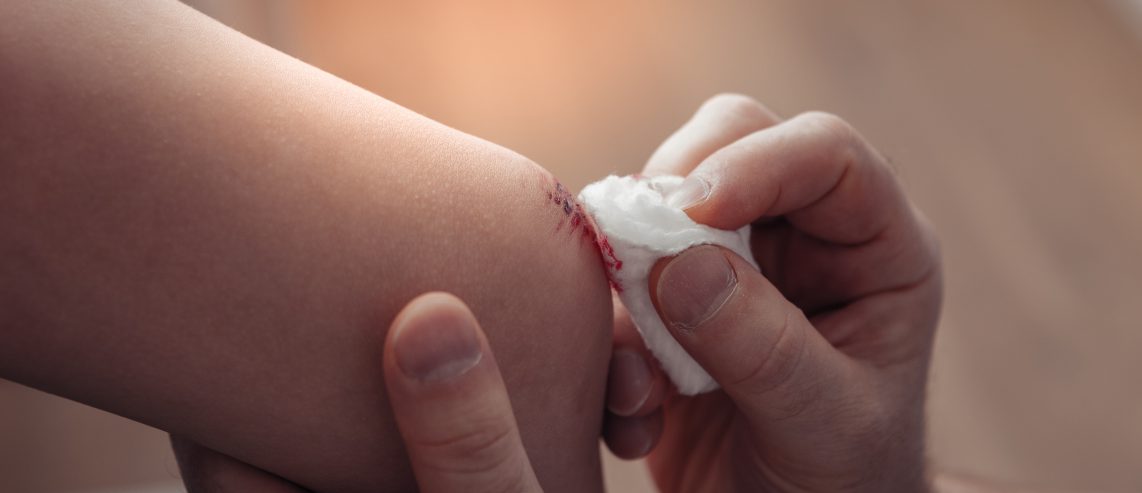Your knife slips and cuts your finger while you’re slicing potatoes. Your child scrapes her knee at the playground. No matter how careful you are, accidents happen in day-to-day life.
The good news is that you can treat many small cuts and scrapes at home. The first step is cleaning the wound properly.
Why Is Cleaning a Wound Important?
It’s essential to clean a wound thoroughly before covering it with a bandage. Any debris left behind (like dirt or gravel) can trigger more problems. Bacteria in the wound can cause infection.
Your body does a great job of healing on its own. You can help by keeping an injured area clean.
Never Miss a Beat!
Subscribe to Our HealthBeat Newsletter!
Thank you for subscribing!
You can now select the specific newsletters you'd like to receive.
You are already subscribed.
Subscribe to more newsletters in our email preference center.
Sorry, an error occurred. Please try again later.
Get Healthy Tips Sent to Your Phone!
How to Clean a Wound
Here are the steps you should take when cleaning a wound.
- Wash your hands
Wash and dry your hands thoroughly to cut down on the risk of infection. If you have disposable gloves handy, wear those as well. - Apply pressure to stop the bleeding
Before treating the wound, you need to stop the bleeding. Cover the wound with a clean, dry cloth (or sterile gauze pads if you have them). Apply light pressure for a few minutes to slow or stop the bleeding. - Rinse the wound
Run water over the wound, looking out for any debris like dirt or gravel. When rinsing the wound, you may also use a saline solution for wound care (available at drugstores) or diluted soap. Store-bought saline solutions for wound care have a low concentration of salt and should not sting. - Clean the area around the wound
Use mild soap and a washcloth to gently clean the area around the wound. This will further reduce the chance of infection. - Pat the skin dry
Use another clean towel or gauze to gently dry the wound. Don’t use cotton balls or anything with fibers that can stick to the wound. - Apply a barrier
Spread a thin layer of petroleum jelly over the cut or scrape to keep it from drying out. Wounds heal faster and with less scarring in a moist environment. You can also opt for an antibacterial ointment such as Neosporin, which fights bacteria and provides moisture. - Cover the wound
A sterile bandage will help keep contaminants away from the wound. Change the bandage at least once a day, or more often if it gets wet or dirty.
What Is the Best Way to Disinfect a Wound?
People used to disinfect wounds with harsh solutions like iodine and hydrogen peroxide. But these chemicals can damage human tissue. Save them for disinfecting household surfaces like countertops.
Nowadays, doctors recommend a mild saline solution or soapy water for cleaning a wound. After you wash the wound, rinse the area again with clear water.
When Should You Call the Doctor?
Sometimes a minor wound turns out to be more serious. In this case, you may need stitches. Seek medical attention if the wound:
- Continues to bleed after 5 minutes of applied pressure.
- Has a foreign object embedded in it (like a piece of glass or gravel).
- Is longer than ¾ of an inch, or deeper than ¼ of an inch.
- Cuts across a joint.
- Has jagged edges.
- Came from an animal or human bite.
- Came from a rusty or dirty object (you may need a tetanus shot).
Be on the lookout for signs of infection, like a wound that’s red, swollen, or oozing pus. If the wound doesn’t seem to be healing in a week or so, it’s time to call the doctor.
How to Prevent Scarring
Even a minor cut can leave a scar. A scar is a natural part of the healing process. To reduce the amount of scarring:
- Keep the wound clean.
- Keep the wound covered until it heals.
- Use a layer of petroleum jelly to keep the wound moist. It keeps the wound from drying out and forming a scab.
- Change the bandage daily.
- Use sunscreen on the wound after it has healed.
Sources
About UPMC
Headquartered in Pittsburgh, UPMC is a world-renowned health care provider and insurer. We operate 40 hospitals and 800 doctors’ offices and outpatient centers, with locations throughout Pennsylvania, Maryland, New York, West Virginia, and internationally. We employ 4,900 physicians, and we are leaders in clinical care, groundbreaking research, and treatment breakthroughs. U.S. News & World Report consistently ranks UPMC Presbyterian Shadyside as one of the nation’s best hospitals in many specialties and ranks UPMC Children’s Hospital of Pittsburgh on its Honor Roll of America’s Best Children’s Hospitals. We are dedicated to providing Life Changing Medicine to our communities.
